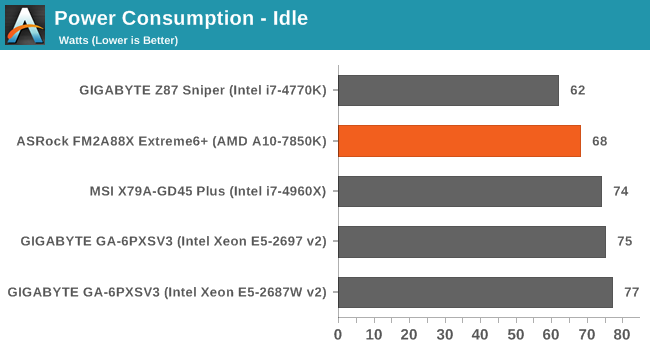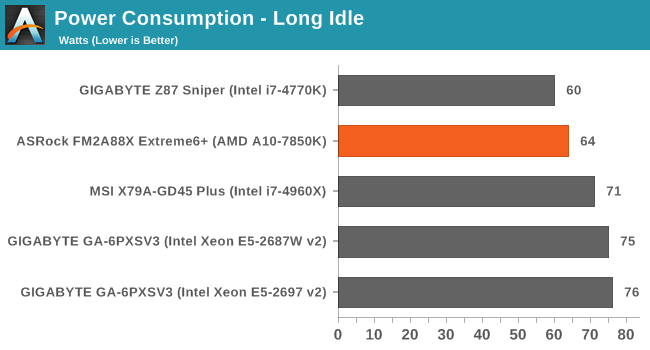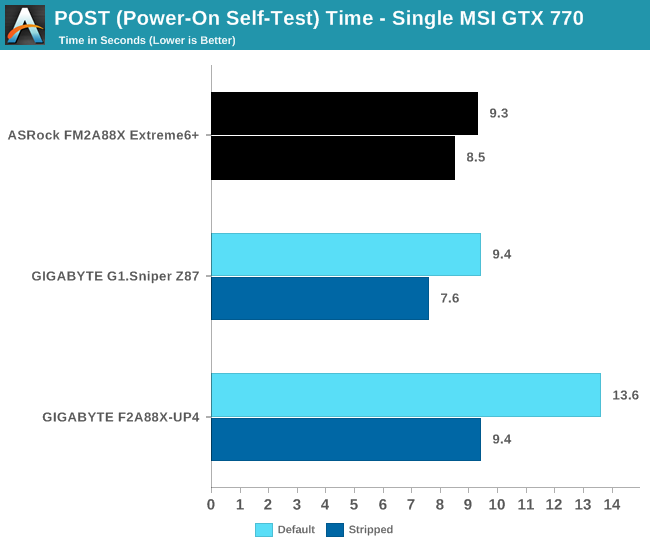ASRock FM2A88X Extreme6+ Review
by Ian Cutress on March 19, 2014 11:59 AM ESTMany thanks to...
We must thank the following companies for kindly providing hardware for our test bed:
Thank you to OCZ for providing us with 1250W Gold Power Supplies and SSDs.
Thank you to G.Skill and ADATA for providing us with memory kits.
Thank you to Corsair for providing us with an AX1200i PSU, Corsair H80i CLC and 16GB 2400C10 memory.
Thank you to ASUS for providing us with the AMD HD7970 GPUs and some IO Testing kit.
Thank you to MSI for providing us with the NVIDIA GTX 770 Lightning GPUs.
Thank you to Rosewill for providing us with the 500W Platinum Power Supply for mITX testing, BlackHawk Ultra, and 1600W Hercules PSU for extreme dual CPU + quad GPU testing, and RK-9100 keyboards.
Thank you to ASRock for providing us with the 802.11ac wireless router for testing.
| Test Setup | |
| Processor |
AMD A10-7850K (ES) 2 Modules, 4 Threads 3700 MHz, 4000 MHz Turbo 4MB L2 Cache |
| Motherboards | ASRock FM2A88X Extreme6+ |
| Cooling |
Corsair H80i Thermalright TRUE Copper |
| Power Supply |
OCZ 1250W Gold ZX Series Corsair AX1200i Platinum PSU |
| Memory | AMD Gaming 2x8GB DDR3-2133 10-11-11 Kit |
| Memory Settings | XMP |
| Video Cards |
MSI GTX 770 Lightning 2GB (1150/1202 Boost) ASUS HD7970 3GB (Reference) |
| Video Drivers |
Catalyst 13.12 NVIDIA Drivers 332.21 |
| Hard Drive | OCZ Vertex 3 256GB |
| Optical Drive | LG GH22NS50 |
| Case | Open Test Bed |
| Operating System | Windows 7 64-bit SP1 |
| USB 2/3 Testing | OCZ Vertex 3 240GB with SATA->USB Adaptor |
| WiFi Testing | D-Link DIR-865L 802.11ac Dual Band Router |
Power Consumption
Power consumption was tested on the system as a whole with a wall meter connected to the OCZ 1250W power supply, while in a single MSI GTX 770 Lightning GPU configuration. This power supply is Gold rated, and as I am in the UK on a 230-240 V supply, leads to ~75% efficiency > 50W, and 90%+ efficiency at 250W, which is suitable for both idle and multi-GPU loading. This method of power reading allows us to compare the power management of the UEFI and the board to supply components with power under load, and includes typical PSU losses due to efficiency. These are the real world values that consumers may expect from a typical system (minus the monitor) using this motherboard.
While this method for power measurement may not be ideal, and you feel these numbers are not representative due to the high wattage power supply being used (we use the same PSU to remain consistent over a series of reviews, and the fact that some boards on our test bed get tested with three or four high powered GPUs), the important point to take away is the relationship between the numbers. These boards are all under the same conditions, and thus the differences between them should be easy to spot.



Windows 7 POST Time
Different motherboards have different POST sequences before an operating system is initialized. A lot of this is dependent on the board itself, and POST boot time is determined by the controllers on board (and the sequence of how those extras are organized). As part of our testing, we are now going to look at the POST Boot Time - this is the time from pressing the ON button on the computer to when Windows 7 starts loading. (We discount Windows loading as it is highly variable given Windows specific features.) These results are subject to human error, so please allow +/- 1 second in these results.

ASRock have historically been good with POST times, and under 10 seconds is a good score.










44 Comments
View All Comments
5thaccount - Thursday, March 20, 2014 - link
I know this isn't a review of the APU, but I'm very curious why it wasn't benched against a Celeron / i3 / i5 in the system and game benchmarks. I wouldn't expect this to come near i7 / Xeon territory (although, to it's credit, it did better than I was expecting). Was it only to strictly compare relative performance to the fastest Intel can provide? I'd be curious to see how it fared against similarly priced and cheaper Intel CPUs - especially in the game benchmarks.aike - Friday, March 21, 2014 - link
All the shock practice on the devices can be used keep on effort just by advantage about keeping effort or possibly at home process. All the devices undeniably construct over to any <a href="http://www.katalog.cc/">rolex replica</a> private??? lenses temperament, considering that it adds something to a?? lenses is visually and additionally trend.aike - Friday, March 21, 2014 - link
Genuinely, each one of on top of exploit fundamental purpose typically the copy wholesale handbags turned out to be some type of shrewd undermine concerning trendy finishing touches an increasing number of gals get to approve perhaps even booty.http://www.oakleafgardenmachinery.co.uk/superrepli...DrMrLordX - Saturday, March 22, 2014 - link
Thank you for taking the time to review this board, Mr. Cutress. I am curious about CPU throttling under heavy IGP load. Did you experience this problem? Some have attributed this to VRM temperatures, but others have observed that this may be related to a design decision on AMD's part to keep total power delivery to the chip within a specific TDP envelope, even when overclocking is present.I have been trying to figure out which AM2+ boards can mitigate or defeat this throttling behavior through UEFI settings. There is another way not involving the UEFI:
http://www.overclock.net/t/1459225/i-have-custom-l...
but it would be much nicer to tweak the UEFI to defeat this p5 state behavior. People with "good" cooling on the CPU and VRMs are still getting throttling, at least on some boards, some of the time . . . it's hard to nail down exactly who has this problem.